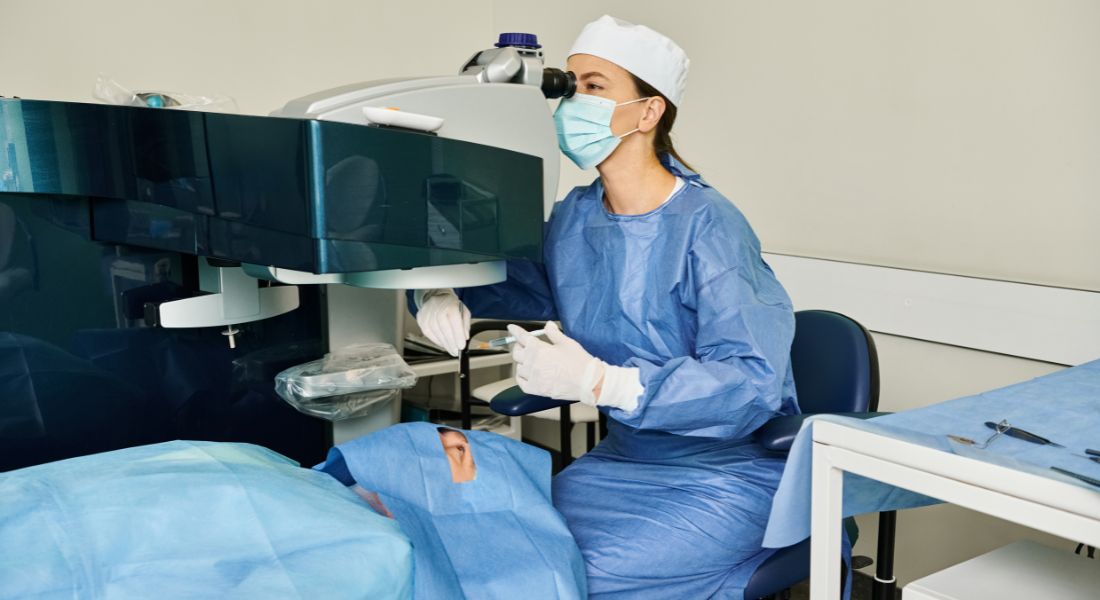Blade-Free LASIK Surgery: Is It Better Than Traditional?

If you’ve been thinking about correcting your vision with LASIK, one question you might already be asking yourself is, “Should I choose blade-free LASIK or the traditional method?” Both approaches are designed to help you see clearly without glasses or contact lenses, but they’re not identical. The difference lies mainly in how the corneal flap is created, and that single step can shape your comfort, safety and final visual outcome.
In this guide, I want to walk you through both options in detail, using simple language that helps you understand the technology, what to expect, and which method might be a better fit for your eyes. Whether you’re short-sighted, long-sighted or have astigmatism, knowing the pros and cons of blade-free versus traditional LASIK will help you make an informed, confident decision about your treatment.
What Is LASIK and How Does It Work?
LASIK (Laser-Assisted In Situ Keratomileusis) is one of the most popular and successful vision correction procedures in the world. It reshapes your cornea to improve how light enters your eye, allowing you to see clearly without glasses or lenses.
LASIK involves two main steps:
- Creating a corneal flap
- Reshaping the underlying corneal tissue using an excimer laser
Blade-free LASIK and traditional LASIK differ only in the first step.
Blade-Free LASIK vs Traditional LASIK: The Key Difference

Traditional LASIK
Uses a microkeratome blade a tiny mechanical device to create the flap.
Blade-Free LASIK (Femtosecond LASIK)
Uses a femtosecond laser instead of a blade to create the flap.
This difference may feel small, but it has a major impact on:
- Accuracy
- Flap consistency
- Patient comfort
- Safety
- Recovery
- Suitability for more eye types
Let’s explore these differences in detail.
How the Traditional LASIK Flap Is Created
In traditional LASIK, a microkeratome blade gently cuts a thin flap across the surface of your cornea.
How it works:
- The device is placed on your eye
- Suction stabilises the eye
- The blade passes across the cornea
- A flap is created and lifted
Traditional LASIK has been used safely for decades, but the blade introduces some variability because it relies on mechanical movement.
How Blade-Free LASIK Creates the Flap
Blade-free LASIK uses a femtosecond laser to create thousands of tiny bubbles inside the cornea. These bubbles form a clean, precise flap that can be lifted without a blade ever touching your eye.
How it works:
- A computer-guided laser maps your cornea
- Laser pulses create microscopic bubbles
- The flap is gently lifted
This technology allows for extreme precision and uniformity.
Accuracy: Which Method Is More Precise?
Blade-free LASIK is widely considered the more precise method.
Why?
- The laser creates a predictable flap thickness
- The edges are cleaner
- The shape is more consistent
- It allows customisation based on your unique cornea
In contrast, the microkeratome blade can introduce slight variations in depth or position.
Result:
Blade-free LASIK offers superior accuracy especially important for people with irregular corneas or higher prescriptions.
Safety Comparison: Which Is Safer?
Both methods are safe when performed by an experienced surgeon, but blade-free LASIK has some safety advantages.
Blade-Free LASIK Safety Benefits:
- Lower risk of flap complications
- No blade-related cuts
- Greater precision
- Suitable for thinner corneas
- Less chance of creating an irregular flap
Traditional LASIK Safety Profile:
- Still very safe
- Decades of successful results
- Slightly higher risk of flap issues due to the blade
If you want the safest option available today, blade-free LASIK generally comes out on top.
Comfort During the Procedure
You’ll be relieved to know that both treatments are quick and painless thanks to numbing drops.
Traditional LASIK Comfort:
- You may feel more pressure
- The blade’s movement can feel unusual
Blade-Free LASIK Comfort:
- Typically more comfortable
- Less pressure sensation
- A quieter, smoother experience
Patients often describe blade-free LASIK as less intimidating.
Visual Results: Are the Outcomes Different?
Both methods have excellent visual outcomes, but blade-free LASIK may offer slightly better consistency.
Traditional LASIK Results:
- Excellent for most prescriptions
- High accuracy for suitable eyes
Blade-Free LASIK Results:
- More reliable across a wider range of eye shapes
- Better for high prescriptions
- Improved flap quality leads to stable results
Overall, both methods work well, but blade-free is usually preferred for its predictability.
Who Is Suitable for Traditional LASIK?

You may be a good candidate for traditional LASIK if:
- Your corneas are thick
- Your prescription is moderate
- You want a cost-effective solution
- You have a straightforward eye structure
Traditional LASIK is still commonly used and highly effective.
Who Is Suitable for Blade-Free LASIK?
You may be better suited for blade-free LASIK if:
- You have thinner corneas
- Your prescription is high
- Your corneal shape is irregular
- You want maximum safety
- You prefer cutting-edge technology
- You’re prone to dry eye
- You want more predictable flap creation
Blade-free LASIK expands eligibility for people who may not qualify for traditional LASIK.
Differences in Flap Healing
Because blade-free flaps are more uniform, healing can be faster and more comfortable.
Blade-Free Healing:
- Cleaner edges
- Better alignment
- Lower risk of flap-related dry eye
Traditional Healing:
- Still effective
- Slightly higher variability
- Depends on blade precision
Downtime and Recovery
Both methods offer quick recovery, but blade-free recovery may feel smoother.
Traditional LASIK Recovery:
- Clear vision within one day
- Mild dryness
- Light sensitivity
- Flap healing within a few days
Blade-Free LASIK Recovery:
- Often sharper vision sooner
- More comfort
- Lower dryness risk
- Smoother flap integration
Complications: What to Expect
Complications are rare, but here’s how they differ.
Traditional LASIK Possible Complications:
- Irregular flap edge
- Epithelial ingrowth
- Flap dislocation (rare)
- Microkeratome-related issues
Blade-Free LASIK Possible Complications:
- Transient light sensitivity (rare and temporary)
- Slight inflammation initially
Blade-free LASIK eliminates blade-related issues entirely.
Which Is Better for Thick vs Thin Corneas?
Thick Corneas → Both Suitable
Traditional LASIK works well.
Thin Corneas → Blade-Free Preferred
Femtosecond flaps can be made thinner and more safely.
Which Option Works Best for Astigmatism?
Blade-free LASIK tends to be more accurate for astigmatism because:
- Flap thickness is more even
- Centration is more precise
- Custom laser mapping improves alignment
Traditional LASIK can still treat astigmatism, but with greater variability.
LASIK for High Prescriptions

High myopia or astigmatism needs the most accuracy.
Blade-Free LASIK:
- Usually recommended
- More stable flap creation
- Better outcomes for challenging cases
Traditional LASIK:
- Still effective
- May be more limited for extreme prescriptions
Cost Comparison: Which Is More Affordable?
Traditional LASIK:
- Generally less expensive
- Good for straightforward cases
Blade-Free LASIK:
- Slightly more expensive
- Higher precision and safety
- Technology-driven price difference
Many people feel the extra cost is worth the peace of mind.
FAQs:
- Is blade-free LASIK actually safer than traditional LASIK?
Yes, blade-free LASIK is generally considered safer because the femtosecond laser creates the corneal flap with a level of precision that a mechanical blade cannot match. Since no blade touches the eye, the chances of flap-related complications such as uneven cuts or partial flaps are significantly reduced. Traditional LASIK is still very safe and has been performed successfully for decades, but the mechanical nature of the microkeratome introduces slightly more variability. If safety is your top priority, the laser-based approach usually offers the most predictable and reliable results. - Does blade-free LASIK give better vision than traditional LASIK?
Both techniques are capable of producing excellent visual outcomes, and many patients achieve 20/20 vision or better with either method. However, blade-free LASIK provides greater consistency because the flap is created with exact thickness and shape, reducing the chance of irregularities that might affect the laser reshaping step. This level of precision can be particularly beneficial for people with higher prescriptions or slightly irregular corneas, making the final result more stable and predictable. While traditional LASIK still produces outstanding results in the right candidates, blade-free surgery offers a higher degree of refinement. - Is the blade-free LASIK procedure less painful?
Both procedures are painless thanks to numbing eye drops, but most patients report that blade-free LASIK feels more comfortable during the flap creation step. In traditional LASIK, the microkeratome blade can create a sensation of pressure or movement that some people find unsettling. The femtosecond laser used in blade-free LASIK typically feels smoother, quieter and more controlled, which helps reduce anxiety during the procedure. Overall, while neither method is painful, the laser-based approach tends to provide a calmer and more comfortable experience. - Which method heals faster: blade-free or traditional LASIK?
Healing is usually quick with both techniques, but blade-free LASIK often results in slightly faster and smoother recovery because the flap tends to be more uniform. When the flap aligns perfectly and sits flush against the corneal surface, your eyes can stabilise more efficiently. This may lead to sharper vision sooner and fewer fluctuations in clarity during the first few days. Traditional LASIK also heals swiftly, but minor variations in flap thickness or shape may result in subtle differences in early recovery. For most patients, both methods allow a return to normal activities within 24 hours. - Can people with thin corneas get blade-free LASIK?
Yes, blade-free LASIK is often recommended for people with thin corneas because the femtosecond laser can create a thinner, more controlled flap than the microkeratome blade. Traditional LASIK requires a thicker flap to ensure stability, which may make some patients unsuitable candidates. The laser’s precision allows surgeons to preserve more corneal tissue, which is essential for maintaining long-term corneal strength. This means that people who were previously told they weren’t suitable for traditional LASIK may still qualify for blade-free treatment after a detailed evaluation. - Is blade-free LASIK better for treating astigmatism?
Blade-free LASIK is generally considered more effective for astigmatism because it creates a flap with consistent thickness and highly accurate centration. When treating astigmatism, even minor misalignment can affect the quality of the results. The femtosecond laser’s accuracy ensures that the excimer laser can reshape the cornea exactly as planned, improving the symmetry and clarity of the final visual outcome. Traditional LASIK can still treat astigmatism successfully, but the mechanical blade may introduce small variations that aren’t ideal for higher or irregular astigmatic prescriptions. - Are the results of blade-free LASIK more stable in the long term?
In most cases, blade-free LASIK offers slightly more stable results because of the precision involved in creating the corneal flap. The uniform shape and smooth edges help the flap settle securely, reducing the likelihood of small irregularities that might affect healing. Over time, this can contribute to more consistent visual quality, especially in patients with higher prescriptions or unique corneal shapes. Traditional LASIK still provides excellent long-term stability for the majority of patients, but the greater customisation possible with blade-free technology gives it a small advantage. - Is blade-free LASIK worth the higher cost?
Many patients feel that blade-free LASIK is worth the additional cost because the technology offers greater accuracy, comfort and safety. The femtosecond laser reduces the likelihood of blade-related complications and extends eligibility to people who might not qualify for traditional LASIK. While traditional LASIK is more affordable and still produces excellent results, the extra investment in blade-free treatment often provides added peace of mind. The decision ultimately depends on your prescription, corneal thickness, lifestyle and personal preference after consulting with your surgeon. - Can blade-free LASIK treat higher prescriptions more effectively?
Yes, blade-free LASIK is usually the preferred method for higher levels of myopia, hyperopia or astigmatism because of its superior accuracy in creating the flap. When dealing with stronger prescriptions, the reshaping step becomes more critical, and precise flap creation ensures that the excimer laser treatment is applied exactly where it’s needed. This helps achieve better results and reduces the risk of complications. Traditional LASIK can still treat moderately high prescriptions, but many surgeons prefer the laser-based approach for more complex cases. - Who should choose traditional LASIK instead of blade-free LASIK?
Traditional LASIK may still be a suitable choice for people with thick corneas, straightforward prescriptions and a desire for a more cost-effective option. It remains a widely used technique with a long track record of excellent outcomes. If your eyes have ideal measurements and no irregularities, traditional LASIK can provide visual improvement comparable to blade-free surgery at a lower price. However, most surgeons now recommend blade-free LASIK whenever possible because it offers broader eligibility, fewer variables and enhanced precision.
Final Thought: Is LASIK Right for You?
LASIK remains one of the most reliable and effective ways to achieve long-term freedom from glasses and contact lenses. With quick recovery, high success rates and results that continue to impress patients year after year, it’s a treatment worth considering if you’re ready for clearer vision without daily eyewear. Many people also appreciate how the procedure fits easily into a busy schedule, with minimal downtime and long-lasting visual benefits.
If you’d like to find out whether Lasik surgery in London is suitable for you, you can get in touch with us at the Eye Clinic London to book a consultation. Our team can guide you through your options, assess your eye health and help you make a confident, informed decision about your next steps. We’re here to ensure you feel supported throughout the process and fully understand what to expect before and after treatment.
References:
- Xia, L.-K., Yu, J., Chai, G.-R., Wang, D. & Li, Y. (2015) ‘Comparison of the femtosecond laser and mechanical microkeratome for flap cutting in LASIK’, International Journal of Ophthalmology, 8(6), pp. 784-790. Available at: https://www.ncbi.nlm.nih.gov/pmc/articles/PMC4539628/
- Kahuam-López, N. et al. (2018) ‘Femtosecond laser versus mechanical microkeratome use for LASIK flap creation’, Clinical Ophthalmology, 12, pp. 2213-2220. Available at: https://www.ncbi.nlm.nih.gov/pmc/articles/PMC6491062/
- Kanclerz, P. & Khoramnia, R. (2021) ‘Flap Thickness and the Risk of Complications in Mechanical Microkeratome and Femtosecond Laser In Situ Keratomileusis: A Literature Review and Statistical Analysis’, Diagnostics, 11(9), 1588. Available at: https://www.mdpi.com/2075-4418/11/9/1588
- Yan, Q. et al. (2022) ‘Femtosecond Laser-Assisted Ophthalmic Surgery’, Micromachines, 13(10), 1653. Available at: https://www.mdpi.com/2072-666X/13/10/1653
- Kosar, C.B., et al. (2013) ‘Comparison of visual acuity, refractive results and satisfaction between LASIK performed with a femtosecond laser and a Hansatome microkeratome’, Clinical Ophthalmology, 7, pp. 1883-1889. Available at: https://pmc.ncbi.nlm.nih.gov/articles/PMC3693019/

